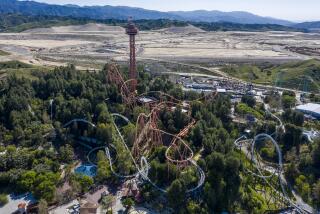Six Flags Vows to Monitor Its Thrill Rides
- Share via
WASHINGTON — Six Flags pledged Tuesday to report all potential roller coaster-related brain injuries for medical research and tracking. But critics said the move is little more than a public relations ploy to fend off government regulation.
The pledge comes at a time of increased scrutiny of whether amusement park thrill rides can cause brain bleeds or other injuries and has triggered national debate on whether there should be government oversight.
Six Flags said it would report injuries to the American Assn. for Neurological Surgeons, which said it intends to develop its own monitoring system that would encourage hospitals and physicians across the country to report any ride-related brain injuries.
The announcements Tuesday follow the release of two Six Flags’ commissioned studies that concluded there is no link between roller coasters and brain injuries and that the G-forces experienced on thrill rides are well within safe levels. The study suggested, however, that further review is needed to determine whether some riders are at greater risk of injury.
Safety advocates, however, said they were not swayed by the studies or the announcement that Six Flags planned to voluntarily report injuries. They renewed their call for federal oversight of the amusement park industry.
“I think this is an effort to head off legislation, plain and simple,” said Ann Brown, former chairwoman of the Consumer Products Safety Commission. “However well-intentioned the industry is, it’s just too difficult for the industry to police itself.... Isn’t it the case of the fox guarding the hen house?”
Rep. Ed Markey (D-Mass.) has been leading the effort in Congress to pass the National Amusement Park Ride Safety Act, which would give the safety commission power to track injuries, investigate serious accidents and order changes to unsafe rides. The legislation has stalled for the last several years, but Markey plans to reintroduce the legislation this congressional session.
Amusement park safety has been hotly debated in recent years, driven in part by a series of accidents. Consequently, California lawmakers in 1999 adopted legislation requiring parks to report injuries and giving state investigators power to order changes if they find design or safety flaws during an accident investigation.
Many other states also have regulations, but critics say there is too much variation among states and no single clearinghouse to track injuries and accident trends. The issue of reporting brain injuries is even more controversial because symptoms may not appear immediately.
More recently, the debate on amusement park safety has turned to G-forces and brain injuries because of several high-profile deaths allegedly related to Goliath at Six Flags Magic Mountain, Montezuma’s Revenge at Knott’s Berry Farm and Indiana Jones Adventure at Disneyland and a series of published cases and reports in medical journals.
Until now, no amusement park company had embarked on a public study. And no other operator has pledged, like Six Flags, to report future brain injuries to the American Assn. of Neurological Surgeons.
Six Flags President Gary Story said he is working on a similar plan to report all ride-related injuries, including brain injuries, to another outside association, the American College of Emergency Physicians, for analysis and monitoring. Likewise, the industry group, the International Assn. of Amusement Parks and Attractions, announced a voluntary reporting program it launched last year with theme parks reporting injuries to an outside auditor.
“While these two studies point to no trends today, we will continue our efforts to monitor our safety records in order to reassure our patrons of our commitment to their safety,” said Story.
But critics said that’s not enough, because without regulation there’s no federal enforcement. Even if the neurological association or Six Flags notices a pattern of injury, there would be no agency with the power to force them to change or even fix the problem -- and no national clearinghouse to inform a park in another state with the same roller coaster that the design might be flawed.
“If they had faith ... they’d put them out there for everyone to see,” said SaferParks founder Kathy Fackler, whose son suffered a foot injury on the Big Thunder Mountain roller coaster at Disneyland.
Rachelle Johnston, 34, a former model who says she has suffered from more than 1,000 seizures since riding the Joker’s Revenge roller coaster at Six Flags Fiesta Texas in 1999, said she has no confidence in the industry-sponsored report.
“I’m really saddened by their report because it tells me they’re not looking deep enough,” said Johnston, who suffers from memory loss and slurred speech. “These people ... they have no idea. I would challenge any one of them to live my life for a week, with my disabilities.”
Dr. Robert Harbaugh of the neurological association said a medical panel is still trying to determine how best to capture data from across the country, but hopes to begin its surveillance within six months. That data would come in independently of theme parks and be reported by hospitals and doctors.
Leslie Goodman, senior vice president of strategic communications for Walt Disney Co., which has been the target of at least three lawsuits stemming from brain injuries and one fatality allegedly resulting from the Indiana Jones attraction, said: “We applaud the initiative taken by Six Flags. We welcome efforts by the theme park industry to explore different methods of reporting data for further scientific study.”
And officials from Knott’s Berry Farm, where a woman died after riding the Montezuma’s Revenge roller coaster, said they could not comment on the neurological group’s proposal without further details, but added: “Knott’s does adhere to the California state reporting regulations, which are believed to be some of the most stringent in the country, and will continue to do so.”
The effectiveness of the monitoring remains to be seen.
Dr. Gregory O’Shantick, national medical director of the Brain Injury Assn., an advocacy and research group, said he fears it will result in “grossly incomplete data and probably it’s not going to be that helpful.”
*
Times staff writer Caitlin Liu contributed to this report.
More to Read
Inside the business of entertainment
The Wide Shot brings you news, analysis and insights on everything from streaming wars to production — and what it all means for the future.
You may occasionally receive promotional content from the Los Angeles Times.











